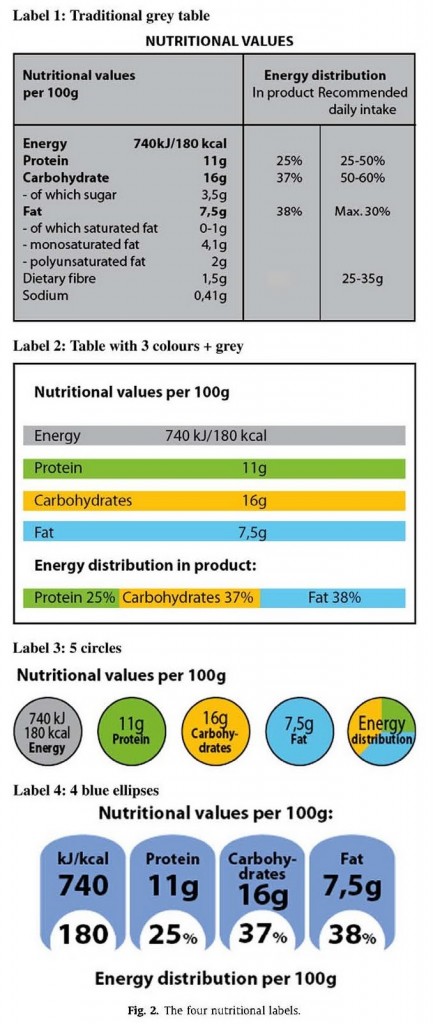Part 4 of our series on food labels looks at what consumers want (or think they want) on food labels, and how this affects their actual buying and eating behavior.
What do people want on food labels?
Generally, in order of preference, people look for:
- calories
- fat content
- sugar content
- cholesterol content
- trans fat content
- protein content
- sodium content
- carbohydrate content
- saturated fat content
Calorie content is far and away the most-read source of nutritional information. As we saw in Part 3, calorie content can have some significant problems.
People often also misinterpret calorie data, or don’t take serving size into account. It’s easy to focus on, say, “150 calories per serving” and think Great! That’s a perfect snack! but not notice that a serving size is a tiny handful.
For instance, a serving of potato chips is about 270 calories… and about 27 chips. That’s 10 calories per chip. When was the last time you ate only 27 potato chips? Go count them out and see what that looks like.

Most people say they don’t really read and interpret numbers – they prefer another, quicker type of reference, such as a color-coded traffic light.
Nor can the experts agree on what they want to see on food labels. Different countries have suggested and used things like:
- international nutrient recommendations to prevent malnutrition
- food composition data
- “expert judgment”
- dietary requirements
- actual average intakes
- existing food standards
- technical and taste arguments
- guessing whether consumers will improve their choices from reading the label.
Ultimately, it’s hard to say what’s best. Although researchers have suggested many ways to validate nutrient profiles, there is no “gold standard”.
We still don’t know what works best, especially considering that different people read labels differently (or don’t read them at all).
Who uses food labels?
Which is another problem: Not everyone uses food labels equally. And we don’t fully know all the factors involved.
However, we do know that food label readers tend to be:
- female
- more educated
- younger
- healthier (or more health-conscious).
For instance, studies of female shoppers have found that around 80% of women do read and use labels.
However, other studies have found that only about 10-15% of people from all demographics (e.g. men, older folks, different income groups, etc.) “always” read labels.
Still other studies point out that sure, people say they read labels… but don’t actually do it. (Just like we all claim that we “eat healthy”, even with cookie crumbs speckling our shirt.)
In one sense, this is a good thing. It means that younger, more educated women, who might be buying groceries for their families or taking care of their own health, are more likely to read food labels.
But it also means that many of the people who really need to know more about their food are not reading the labels.
Or, perhaps, there’s a small subset that worries too much about their food quality – who scrutinize labels obsessively but may miss the important principles. For example, dieters may focus on total calories but not on nutrient quality, and thus decide that 100 calorie “snack packs” of cookies are “healthy”.
As we saw in Part 3, our bodies are not bomb calorimeters. Food quality matters.
Many people say that food labels are confusing, and/or they don’t trust manufacturers to put honest information on the package. These “nutritional mistrusters” don’t read labels either.
“Reading” versus “understanding” food labels
Reading and understanding labels are two different things. One study found that although 80% of shoppers read the labels, only about half to two-thirds of them could actually make sense of the labels.
Research also shows that although parents mean well, and try to make good decisions by reading labels, they’re easily overwhelmed. After all, when the kid in your cart is screaming and you’re trying frantically to shove some groceries in the cart and get home to make dinner… well, it’s easy to overlook the food label.
Manufacturers know that advertising to kids is a great way to override any label-based decisions: get the kids howling for a cartoon character or a fun product, and mom and dad are much less likely to be careful about the details.
Plus, how do you make sense of all that stuff on the label anyway?
Do you care about the percentage of calories from fat, or the carb grams, or the percentage of RDA of calcium, or…? Which one of the 50 brands of breakfast cereal or granola bar is better? They all say “healthy” and “whole grain” on the label! Gah!
Many consumers say that there’s just too much choice, too much confusing information, and too little time in which to make a smart decision.
Is food labeling really helpful?
OK, many people say they want better food labels. Plenty of people are reading them… if not always understanding them.
But do food labels actually change what people buy and eat? Does food labeling actually matter?
The jury is still out on this one.
One problem, again, is that food labels aren’t always very clear or usable. So even if people really do want to read and use labels, they find it hard to do.
Many regions are experimenting with different styles of food labels, such as labels that are more graphic. (See example below.)

OK, so the food label seems easier to understand. But we also know from studies of consumer behavior in many industries that what people say they want and do isn’t always what they truly want and do.
So, a study that looked at a simplified “traffic light” label (the kind that consumers say they prefer) found that yes, consumers understood the traffic light label… but it didn’t matter.
If people were looking for tasty, satisfying foods, they didn’t care about labeling. Generally, folks only checked the package if they were interested in healthiness or controlling their weight.
And if folks were looking for a flavor fiesta or a good ol’ snackytime indulgence, they’d actively avoid any products that seemed “healthy”. (The mistaken assumption: If it’s good for me, it must taste crappy.)
As we saw in Part 3, people’s buying decisions are strongly affected – not always for better – by a “healthiness” label.
What does it all mean?
In Part 5 of this article, we’ll bring all of this together. Stay tuned.
Summary and action tips
- People look for particular information, such as calories or fat content, on food labels, but don’t always interpret this information correctly. Or they may not know how to apply this information to themselves.
- People may read food labels but not understand them.
- People may read food labels but not care.
- People may read food labels, and use that information to make less healthy choices.
- More information, therefore, isn’t always better. Think about what you want out of your food, and why.
- Ask yourself: How and why am I choosing this food? Because it’s convenient? Because the package appeals to me? Because it’s labelled “healthy” (or not)?
- Incorporate more whole, unprocessed foods in your diet. This saves you the time and effort of reading labels, and you don’t have any surprises. An apple is an apple.
To continue learning about food labels, check out part 5 of this article series where we give you some important take-home messages.
If you’re a coach, or you want to be…
You can help people build sustainable nutrition and lifestyle habits that will significantly improve their physical and mental health—while you make a great living doing what you love. We'll show you how.
If you’d like to learn more, consider the PN Level 1 Nutrition Coaching Certification. (You can enroll now at a big discount.)


Share